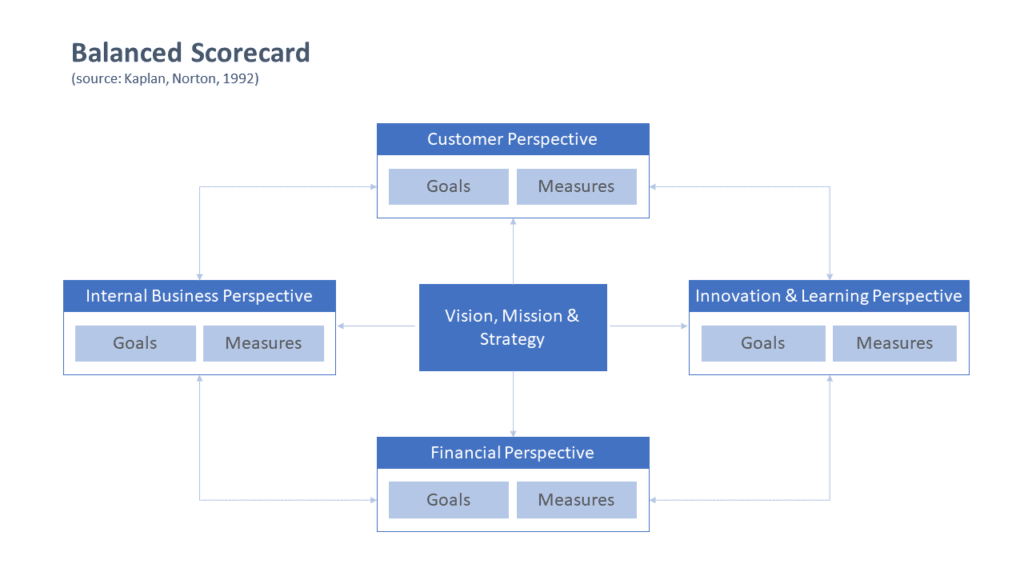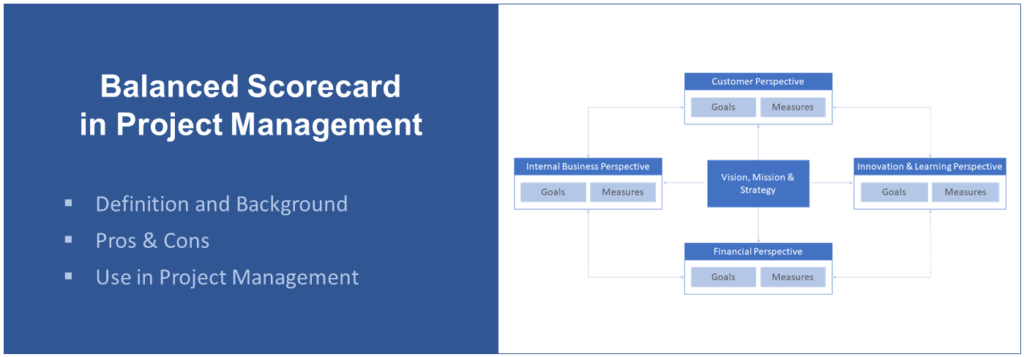The Balanced Scorecard, or Integral Scorecard, is a strategic management methodology used to define and monitor the strategy of an organization. Robert Kaplan and David Norton created this methodology in 1992 (original article). The Balanced Scorecard was originally developed as a tool to implement the corporate strategy and is a common method in companies of all sizes and industries. Thus, it also affects the way projects in many organizations are structured and managed.
In this article, we are introducing the methodology, its strengths and weaknesses as well as the implications for projects and project managers.
What Is the Balanced Scorecard (BSC)?
The Balanced Scorecard allows a company to structure the strategic objectives dynamically and comprehensively. Therefore, it can assess their realization based on a series of indicators that evaluate the performance to achieve their fulfillment.
The BSC is based on the balance and alignment between the elements of the overall strategy and its operational elements. This also includes projects within an organization.
The universal elements are the mission (the purpose), the vision (what the organization aspires to), the core values (what the organization believes in), the perspectives, and the objectives.
On the other hand, the operational elements are the key indicators or KPI (whether induction or result indicators) and strategic initiatives (projects that help you achieve your objectives).
The purposes of a Balanced Scorecard are:
- Describe and communicate an organization’s strategy.
- Measure the strategy implementation and performance.
- Track the actions to improve results.

The 4 Perspectives of the Balanced Scorecard
According to the original method of the Balanced Scorecard, the definition of an organization’s strategy should be carried with four perspectives (source):
- Financial perspective,
- Customer perspective,
- Internal processes perspective, and
- Learning and growth perspective.
These perspectives are also the dimension of a balanced scorecard which are then broken down into goals and measures for the implementation of the overall strategy.
Read on for more details about the different dimensions.
Financial Perspective
For most for-profit organizations, earning a return is a priority. Therefore, for these organizations, this essential perspective has to do with commercial objectives. Basically, any key objective related to the financial health and profitability of the organization can be included in this perspective.
Income and earnings are the apparent financial objectives that most organizations list in this perspective. Other financial goals could include:
- cost savings and efficiency.
- Improving the profit margin.
- Increasing sources of income.
For non-profit or certain public sector organizations, KPIs may relate to cost efficiency and fundraising measures.
Customer Perspective
This perspective focuses on the strategic objectives that are related to customers and the market. In other words, to achieve your financial goals, precisely what do you need to accomplish in terms of your customers and market (s)?
Here, you should find strategic objectives to improve:
- Customer service and satisfaction.
- Market Participation
- Brand recognition.
Non-profit organizations could refer to their beneficiaries and their volunteers and donors as their customer-equivalents. In the public sector, this dimension could refer to the citizens or communities in a region or country.
The Perspective of Internal Processes
What processes does an organization need to implement and meet the strategic financial and customer-related objectives? This is exactly the question that this perspective intends to answer.
This involves setting internal operational goals and objectives. In other words, it defines what processes the organization currently requires and what it must do to improve its performance.
Some examples of internal process perspective objectives are:
- Process improvements.
- Quality optimization.
- Increase the utilization of installed capacity and available resources.
The Perspective of Learning and Growth
While the third perspective focused on the side of concrete processes, the last perspective considers more intangible performance drivers. Because it covers such a broad spectrum, this perspective is often divided into the following components:
- Human resources, e.g. skills, experience, talent, and knowledge.
- Information capital: this consists of databases, networks, information systems, and technological infrastructure, for instance.
- Organizational capital, such as culture, teamwork, leadership, employee alignment, and knowledge management.
What Are the Strengths and Weaknesses of the Balanced Scorecard?
Pros
The Balanced Scorecard methodology introduces several benefits for the management of an organization, among them are:
- Help align all areas and activities of the organization based on strategic objectives and vision fulfillment.
- Stimulates the organizational transformation.
- Transform the vision of the organization into real actions that can be measured and followed.
- It produces an improvement in the organizational processes of information management.
- To improve the internal communication of organizations. As a result, all members know their function to meet their goals.
- It keeps the strategy visible and as the focus of generating measures and KPIs.
- It helps to give a logical structure to the strategy and its implementation.
Cons
The disadvantages and needs for individual adjustments are:
- It requires strong sponsorship from leaders and managers of all levels of an organization to succeed (which is not always the case).
- There is no single template to apply to the BSC. Each organization must create its individual and consistent Balanced Scorecard which can be controversial and time-consuming.
- Due to the increasing number of variants, interpretations, case studies and bibliography on the subject, it can be overwhelming to start applying it.
- It may seem a very rigid methodology because of the logical structure that it proposes.
- Focus areas may deviate among organizations and there are several other tools and methods that could be a better fit for certain types of organizations.
- It is often criticized that the original balanced scorecard would not sufficiently consider the interests of stakeholders other than customers. Thus, it lacks the coverage of supply and extended value chains as well as employee perspectives (source).
- Several ‘enhancements’ of the original BSCs have been developed by different authors, and more stakeholder-focused approaches such as performance prism evolved.
How Are Balanced Scorecard and Project Management Connected?
There are a few possible intersections between project management and the balanced scorecard methods:
BSC Development and Implementation Projects
The development and implementation of a balanced scorecard in an organization can be a project in its own right. It usually involves and affects all divisions and departments of a company and requires cross-functional expertise as well as strong stakeholder management.
Introducing a balanced scorecard as strategy implementation and performance management tool is therefore often done in a project. This strategy project requires methodological project management skills.
Projects to Implement and Achieve Strategic Goals
Projects are a way to implement the strategic goals, one of the contents of a BSC. Organizational and process changes, innovations, new products and services are examples of areas where parts of the vision and strategy of an organization can be implemented through projects.
Aligning Projects with an Organization’s Balanced Scorecard
The most common situation is when projects are done in an organization that uses a balanced scorecard for their strategy implementation.
The Project Management Institute’s Guide to the Project Management Body of Knowledge (PMBOK®, 6th ed., ch. 2.4.4.3) mentions the BSC as a part of the organizational environment of a project. It describes the PMO as “the natural liaison” between such organizational systems, programs and projects.
In addition, the PMBOK requires an alignment of projects with the strategic goals of an organization (PMBOK®, ch. 1) which also involves the BSC as a tool of their implementation (although the PMBOK does not mention the BSC explicitly in that context). It may also need to be integrated into portfolio management (source: Tharp, J. (2007). Align project management with organizational strategy. Paper presented at PMI® Global Congress 2007—Asia Pacific, Hong Kong, People’s Republic of China. Newtown Square, PA: Project Management Institute. Available in PMI’s Learning Library.)
Subsequently, project management needs to address and incorporate goals and measures that derive from an organization’s balanced scorecard.
Project Management and Goals and Measures of a BSC
If a project incorporates goals and measures of the balanced scorecard, it can affect the following areas (non-exhaustive list).
Overall
One of the most important tasks of the Project Integration Management is the alignment of project goals and measures with those of the organization. This does also include the alignment of project goals, aspects and performance indicators with the organization’s BSC.
Financial perspective
- Business case development, cost-benefit analyses and project selection need to be in line with the goals and measures of the BSC.
- Project risk management needs to be consistent with the organization’s risk strategy and appetite.
- Project controlling, such as earned value management, needs to correspond with the financial goals of the company.
Internal processes perspective
- Quality management and cost of quality considerations should correspond with goals and measures of BSC’s internal process perspective.
- Communication and use of organizational assets and processes by a project.
Learning and growth perspective
- Resource management and lessons learned feed into the organization’s learning and growth goals.
- Goals and measures of the learning and growth perspective (e.g. innovativeness) can be used as criteria in a project business case and the project selection.
Customer perspective
- Stakeholder management, communications, scope and quality goals of a project can derive from the customer perspective of the BSC.
- In agile projects, this perspective can determine the level and intensity a product owner engages customers during the product development.
Conclusion
The balanced scorecard is still – almost 30 years after its invention – a popular and common method to implement strategy and related measures.
This also affects projects in organizations that use the BSC. All goals and measures of a project need to be aligned with those of the BSC in this case. This holds true for both traditional as well as agile projects.

